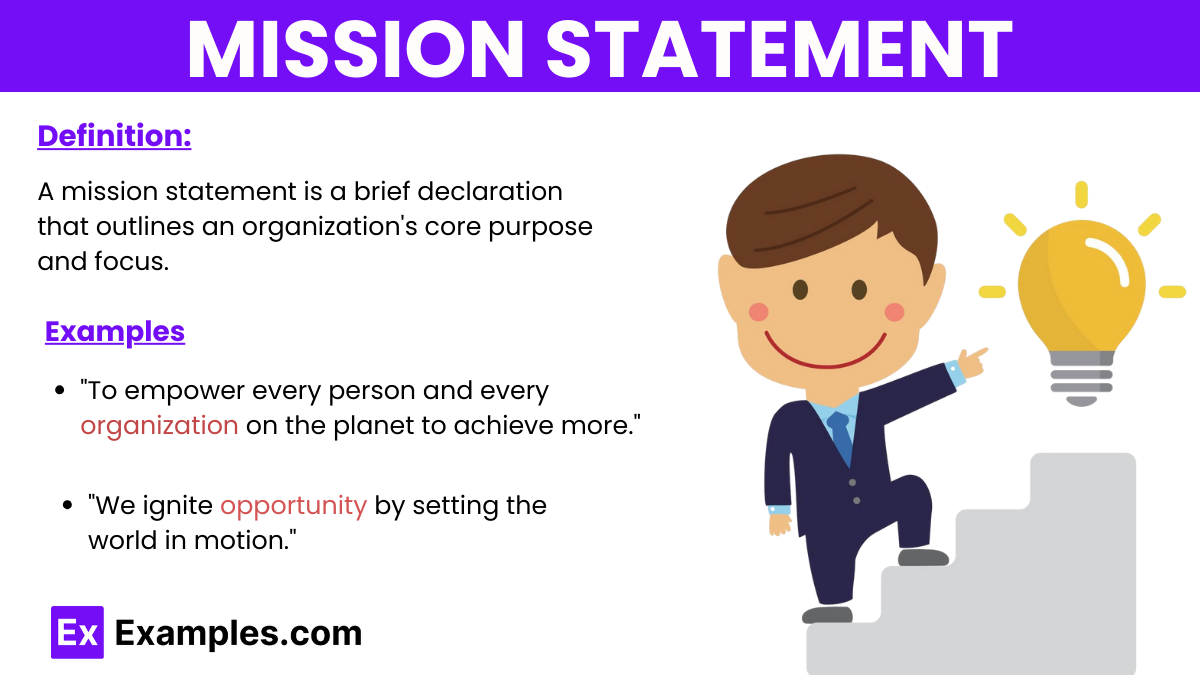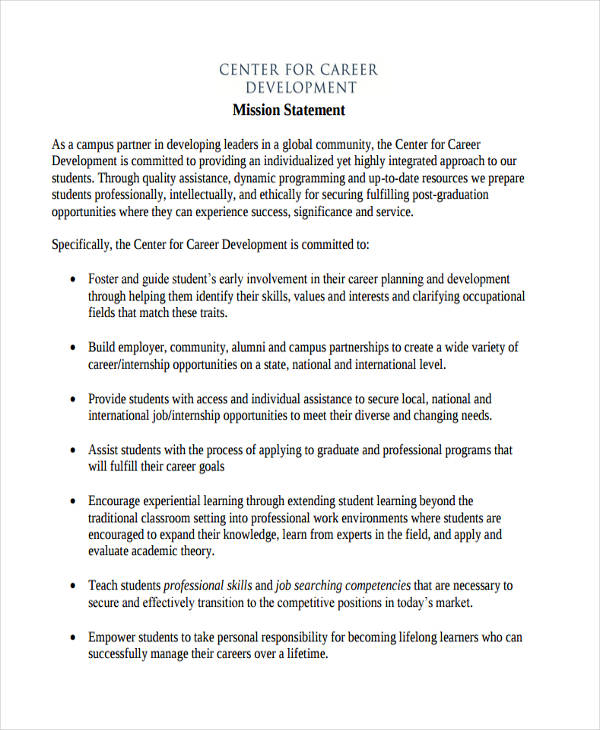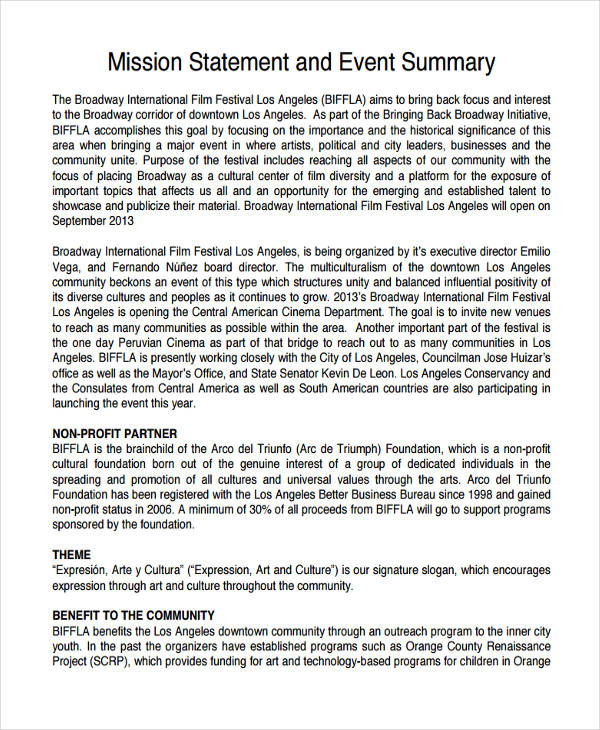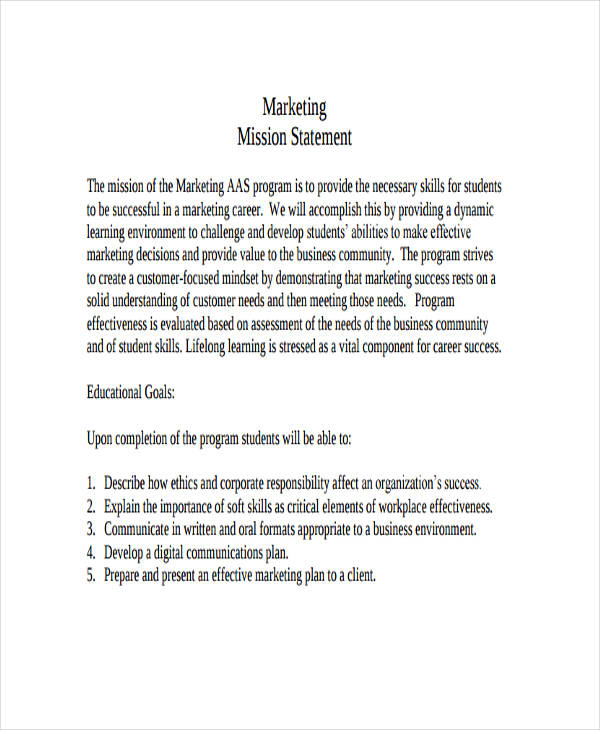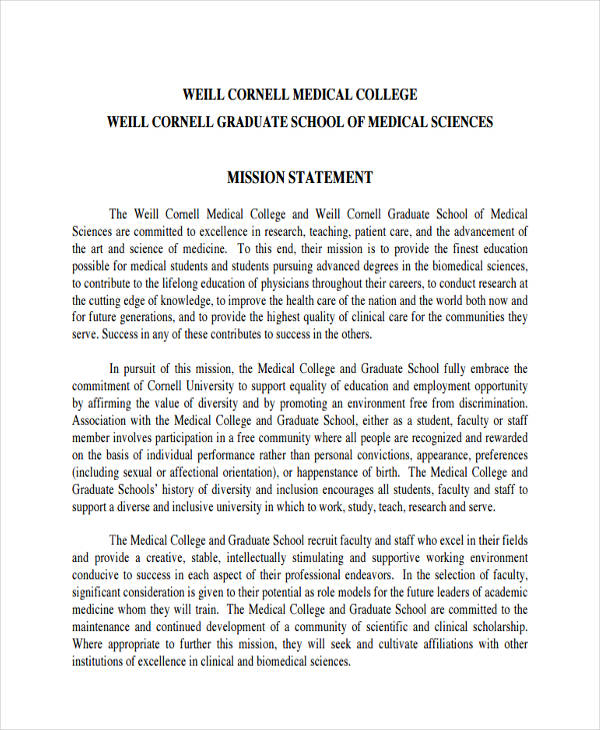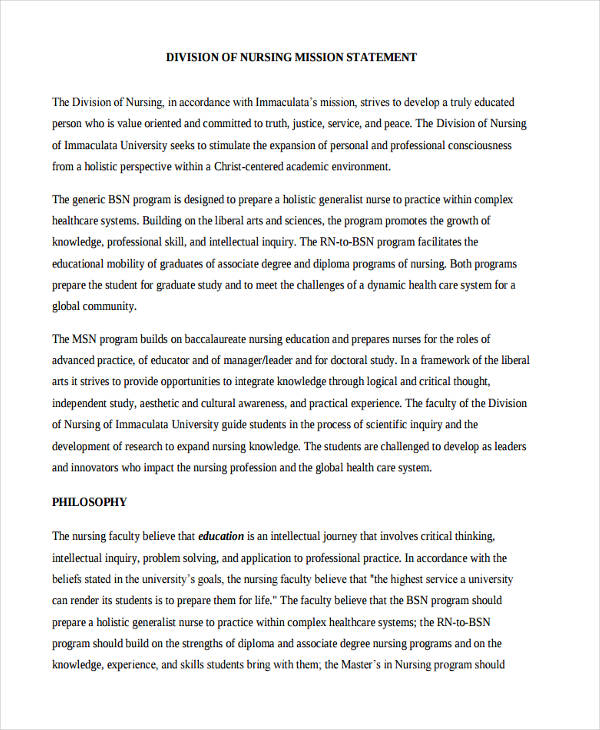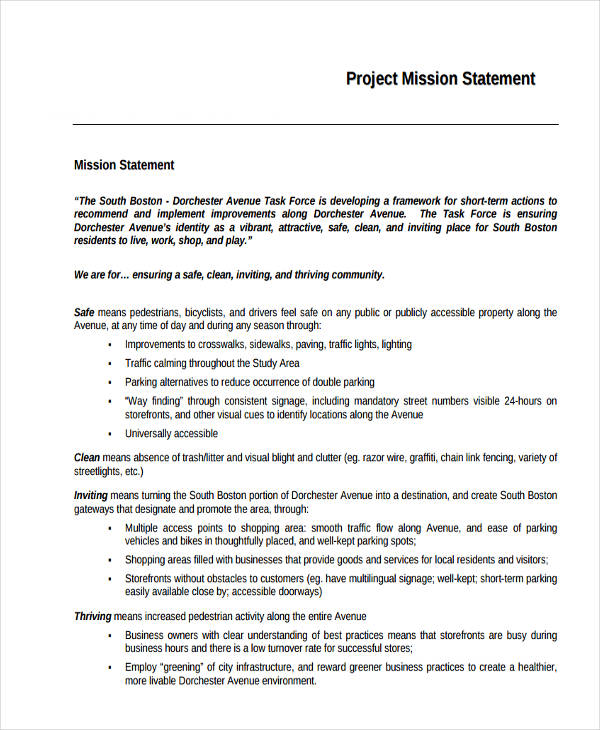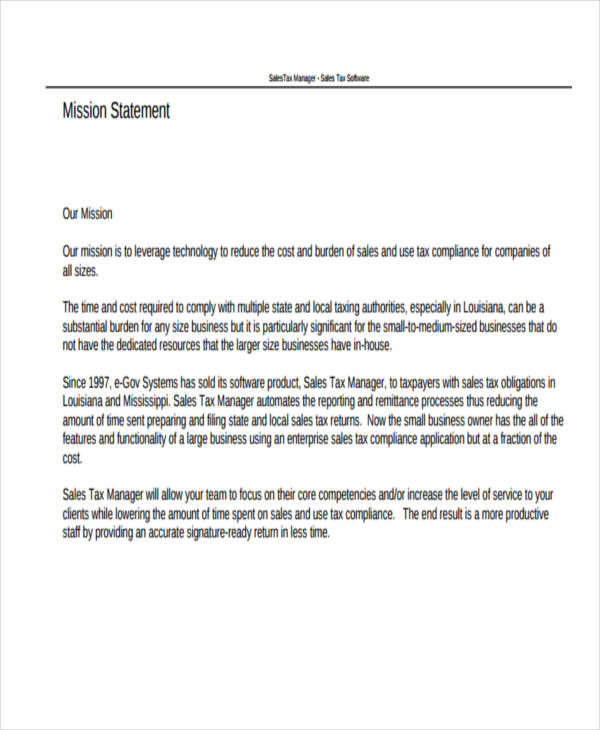22+ Mission Statement Examples
What is a Mission Statement?
A mission statement is a brief declaration that outlines an organization’s core purpose and focus. Serving as a foundational guide, it defines what an organization stands for and its primary objectives. This statement is crucial for setting the direction and aiding in decision-making processes within the organization. It informs both the public and organizational members about what the organization does, whom it serves, and how it serves them.
How to Write a Mission Statement
Writing a mission statement is a critical step for any organization, encapsulating its core values and purpose in a concise and compelling way. Here are the steps to craft an effective mission statement:
Step 1: Define What Your Organization Does
Start by clearly defining what your organization actually does. This includes the basic products or services you provide. Think about the unique aspects of your offerings and how they stand out in the market.
Step 2: Identify Your Core Values
What are the principles that guide your organization? These values should be integral to how you operate and make decisions. They are the foundation upon which you build your business practices and interactions with customers.
Step 3: Determine Who Your Organization Serves
Identify your target audience. Understanding who benefits from your products or services will help tailor your mission statement to speak directly to them.
Step 4: Articulate Your Value Proposition
Explain how your organization adds value to your customers or the community. This involves stating how you solve problems or improve the lives of those you serve.
Step 5: Keep It Concise and Specific
A good mission statement is brief yet powerful. Aim for one to three sentences that encapsulate your purpose, values, and strategic goals without being vague. The clearer and more specific your statement, the more effective it will be.
Step 6: Make It Inspirational
Your mission statement should inspire your team and your stakeholders. It should evoke passion and commitment, reminding everyone why they are a part of your organization.
Step 7: Review and Revise
Once drafted, review your mission statement with key stakeholders, including leadership team members and potential customers. Their insights can help refine the statement to better reflect the organization’s goals and values.
What are the three parts of a mission statement?
A well-crafted mission statement typically consists of three main components that collectively outline an organization’s purpose, strategy, and values. Understanding these components is crucial for developing a mission statement that effectively communicates the organization’s essence and guides its operations. Here are the three essential parts of a mission statement:
Purpose ( What the Organization Does) :
Definition: This part addresses the fundamental reason for the organization’s existence. It answers the question, “What do we do?”
Importance: Clarifying the purpose helps align the internal objectives and actions with the broader goals of the organization.
Example: “To provide educational services that empower students to achieve their full potential.”
Strategy (How the Organization Achieves Its Goals) :
Definition: This component describes the approach or methods the organization uses to achieve its purpose. It outlines the key strategies or actions taken to deliver on the stated purpose.
Importance: Including the strategy in the mission statement connects the organizational activities to its purpose, making the statement actionable and direction-oriented.
Example: “By offering personalized learning experiences and state-of-the-art resources.”
Values (Why the Organization Operates the Way It Does):
Definition: This section highlights the core principles or ethical standards that guide the organization’s decisions and behaviors. It answers the question, “Why do we operate the way we do?”
Importance: The values component reinforces the organizational culture and ethical framework, fostering a unified identity among stakeholders.
Example: “With a commitment to integrity, innovation, and inclusivity.”
Mission statement Types and Examples
Service-Oriented Mission Statement
- This type of mission statement focuses primarily on the services the organization provides and the quality or uniqueness of these services.
- Example: “To deliver unparalleled legal services by focusing on client-specific needs and providing personalized solutions.”
Product-Oriented Mission Statement
- These mission statements concentrate on the products offered by the organization, emphasizing innovation, quality, or value.
- Example: “To create the most innovative, durable, and user-friendly smart home devices that simplify everyday life.”
Technology-Oriented Mission Statement
- Frequently used by tech companies, these statements focus on innovation in technology and how it can improve lives or solve problems.
- Example: “To advance human capabilities by building accessible, reliable, and cutting-edge technological solutions.”
Customer-Oriented Mission Statement
- These statements highlight the relationship with customers and the commitment to providing exceptional customer service, satisfaction, or experiences.
- Example: “To empower our customers by providing them with exceptional financial consultation services that cater to their unique needs and foster long-term financial security.”
Value or Ethic-Oriented Mission Statement
- This type focuses on the core values or ethics that the organization adheres to, often reflecting a commitment to social responsibility, sustainability, or ethical practices.
- Example: “To operate on the principles of sustainability and ethical responsibility, ensuring that every product we produce makes a positive impact on the environment and our community.”
Visionary or Aspirational Mission Statement
- These mission statements express a lofty vision of what the organization seeks to achieve in the future, often looking beyond the immediate products or services to the long-term impact they wish to have.
- Example: “To revolutionize the way the world accesses clean water, making it a right, not a privilege, for every community across the globe.”
Community or Market-Oriented Mission Statement
- These statements focus on the specific community or market the organization serves, emphasizing local involvement, community service, or market leadership.
- Example: “To strengthen community ties by providing locally sourced, fresh produce to urban areas, supporting both local farmers and urban consumers.”
Difference between Mission vs Vision Statements
| Aspect | Mission Statement | Vision Statement |
|---|---|---|
| Focus | Current operations and methods | Future goals and aspirations |
| Purpose | Describes what the organization does now | Describes what the organization aims to become |
| Time Frame | Present | Long-term future |
| Function | Guides daily operations and decision-making | Inspires and motivates towards long-term goals |
| Characteristics | Specific, practical, actionable | Broad, aspirational, inspirational |
| Example | “To provide innovative educational tools that empower students globally to achieve academic excellence.” | “To revolutionize the way the world learns, making quality education accessible to everyone, everywhere.” |
Mission Statement
Purpose: A mission statement describes the organization’s purpose, core values, and the primary means through which it achieves its goals. It answers the questions of what the organization does, whom it serves, and how it serves them.
Present Focus: It focuses on the current operations and how the organization conducts its activities now. It outlines the day-to-day actions, the approach to reaching current goals, and the way it interacts with customers and stakeholders.
Characteristics: Typically concise and specific, mission statements provide a clear and practical guide for decision-making and establish the framework within which the organization operates.
Example of a Mission Statement:
“To provide innovative educational tools that empower students globally to achieve academic excellence.”
Vision Statement
Purpose: A vision statement outlines what the organization aspires to become in the future. It serves as a motivational tool that sets a long-term goal for the organization’s members to strive toward.
Future Focus: It reflects the company’s aspirations and defines the ultimate image of what the organization seeks to achieve in the long run. Vision statements are inherently inspirational and aspirational.
Characteristics: Vision statements are usually broader and more inspirational than mission statements. They are designed to be forward-looking, stretching the imagination and providing a sense of ambition.
Example of a Vision Statement:
“To revolutionize the way the world learns, making quality education accessible to everyone, everywhere.”
Advantages and Disadvantages of Mission Statements
| Aspect | Advantages | Disadvantages |
|---|---|---|
| Direction and Focus | Provides clear direction and focus for organizational activities, aligning everyone with the core purpose. | If too vague or generic, it may fail to provide meaningful guidance, making it difficult to understand or connect with. |
| Motivation and Engagement | Inspires and motivates employees, enhancing engagement and fostering a positive culture. | Overly ambitious goals can demotivate staff and set unrealistic expectations, leading to frustration. |
| Branding and Public Image | Shapes public perception by communicating goals and values, strengthening branding efforts. | Misalignment between the mission statement and actual corporate actions can erode trust and damage reputation. |
| Decision-Making | Acts as a framework for consistent and aligned decision-making, enhancing management cohesion. | An overly rigid mission statement can limit flexibility, preventing adaptation to market changes or new opportunities. |
| Resource Allocation | Guides efficient use of resources by emphasizing critical areas, supporting strategic objectives. | Crafting and revising a mission statement can consume significant time and resources, potentially diverting attention from other critical activities. |
You may be wondering why most of the business become successful but you will be surprised if I told that one of the keys to their success is because of their mission statement. A clear and well-written mission statement partnered with a vision statement sets the business into its highest peak.
That is why it is very crucial for a business (even a small business) to develop and establish a mission statement as this can act as an invisible hand that molds the business as to what it is now and drives the business statement into choosing its right path towards success.
Mission Statement Example
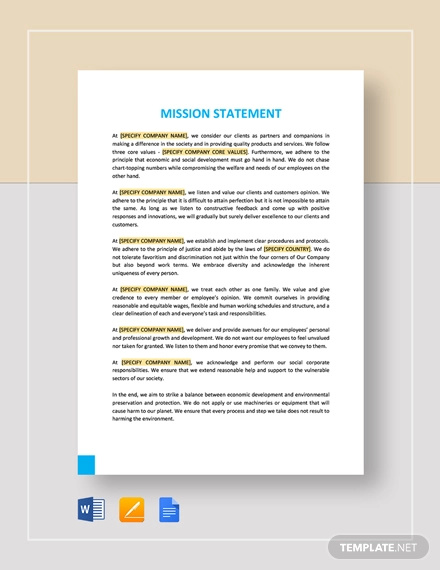
Restaurant Mission Statement Example

Mission Statement

Business Mission Example
Statement of Company Mission
Career Mission Statement
Event Mission Sample
Financial Mission Statement Example
What Should Be Included in a Mission Statement?
A mission statement defines the whole business. A well-written and effective mission statement of work should answer several key questions about your business:
- What is the name of your company?
- What is your business statement?
- What does your business do?
- What does your business hoping to achieve?
- Why do you serve your customer?
- What level of service does your company offer?
- How does your company solve the problems of the customer?
- And what principles that guide your company?
The Importance of Mission Statement in a Company
A mission statement is not only just a plaque on your company’s wall, it is more of a necessity. Here is the three main reason why your company needs a mission statement such as formats like statements in pdf.
- It establishes your company’s direction. The mission statement serves as a guide that steers your company in the right direction towards success.
- It helps your company create better decision-making. A clear written mission statement sets boundaries and limitations which make business owners differentiate between responsibility and authority.
- It focuses on the company’s goal and future. A mission statement analysis will determine what your company did today that will have a big impact on the future of your business.
Marketing Sample Statement
Medical Mission Example
Nursing Statement
Project Mission Statement in PDF
Sales Example
What Is a Personal Mission Statement?
A personal mission statement has the same principle of a mission statement in an organization or company. The only difference is that a personal mission statement defines the life of a person and gives meaning to it.
A personal statement establishes core values and beliefs of a person giving him/her the opportunity to make a better decision to the career or the path of life he/she chooses. Just like a company’s mission statement, a personal mission statement also guides the person in the right direction towards success.
The Purpose of a Vision and Mission Statement
Not only the mission statement of the company that makes a difference. A personal vision statement also takes a huge part too and create an impact statement in the success of a business. Here are the purposes of these two.
- It steers the company in choosing the right direction.
- It inspires the employee as well as the superiors in the company.
- It identifies what is right and wrong and determines the company’s strength and weaknesses.
- It sets boundaries and limitations that make the company solid.
- it clarifies the company statement, smart goals and purpose.
- It defines the company and what it is all about.
Examples of Mission Statement
-
Microsoft: “To empower every person and every organization on the planet to achieve more.”
-
Starbucks: “To inspire and nurture the human spirit—one person, one cup, and one neighborhood at a time.”
-
Coca-Cola: “To refresh the world in mind, body, and spirit. To inspire moments of optimism and happiness through our brands and actions.”
-
Disney: “To entertain, inform, and inspire people around the globe through the power of unparalleled storytelling.”
-
Facebook: “To give people the power to build community and bring the world closer together.”
-
Airbnb: “To help create a world where you can belong anywhere and where people can live in a place, instead of just traveling to it.”
-
Uber: “We ignite opportunity by setting the world in motion.”
-
Apple: “To bring the best user experience to its customers through its innovative hardware, software, and services.”
-
Sony: “To fill the world with emotion, through the power of creativity and technology.”
-
IBM: “To lead in the creation, development, and manufacture of the industry’s most advanced information technologies, including computer systems, software, networking systems, storage devices, and microelectronics.”



